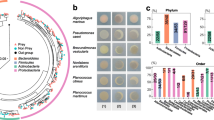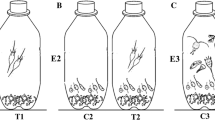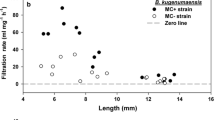Abstract
Bacterial predation is a vital feeding behavior that affects community structure and maintains biodiversity. However, predatory bacterial species in coastal sediments are comparatively poorly described. In this study, the predation capacity of all nine culturable Bradymonabacteria strains belonging to the recently discovered order Bradymonadales was determined against different types of prey. The predatory efficiency of Bradymonabacteria increased as the initial prey proportion in a mixed culture decreased. When the initial prey proportion was 0.5, the number of surviving prey bacterial cells significantly decreased after 4 h of predation with the Bradymonabacteria strains TMQ1, SEH01, B210 and FA350. However, growth of the prey strain occurred in the presence of the Bradymonabacteria strains TMQ4, TMQ2, TMQ3, V1718 and YN101. When the initial prey proportion decreased to 0.1 or 0.01, most of the Bradymonabacteria strains preyed efficiently. Furthermore, established neighboring colonies of prey were destroyed by Bradymonabacteria. This invading predation capacity was determined by the predation ability of the strain and its motility on the agar surface. Our findings provide new insights into the potential ecological significance of predatory Bradymonabacteria, which may serve as a potential probiotic for use in the aquaculture.





Similar content being viewed by others
Data availability
The 16S rRNA gene sequences and bacterial genomes were acquired from the NCBI GenBank database.
Code availability
Not applicable.
References
Aramaki T, Blanc-Mathieu R, Endo H, Ohkubo K, Kanehisa M, Goto S, Ogata H (2020) KofamKOALA: KEGG ortholog assignment based on profile HMM and adaptive score threshold. Bioinformatics 36:2251–2252
Berleman JE, Scott J, Chumley T, Kirby JR (2008) Predataxis behavior in Myxococcus xanthus. Proc Natl Acad Sci U S A 105:17127–17132
Chen H, Laws EA, Martin JL, Berhane T-K, Gulig PA, Williams HN (2018) Relative contributions of Halobacteriovorax and bacteriophage to bacterial cell death under various environmental conditions. mBio 9:e01202–e01218
Felsenstein J (1985) Confidence limits on phylogenies: an approach using the bootstrap. Evolution 39:783–791
Hamidjaja R, Capoulade J, Caton L, Ingham CJ (2020) The cell organization underlying structural colour is involved in Flavobacterium IR1 predation. ISME J 14:2890–2900
Harshey RM (2003) Bacterial motility on a surface: many ways to a common goal. Annu Rev Microbiol 57:249–273
Hillesland KL, Lenski RE, Velicer GJ (2007) Ecological variables affecting predatory success in Myxococcus xanthus. Microb Ecol 53:571–578
Hillesland KL, Velicer GJ, Lenski RE (2009) Experimental evolution of a microbial predator’s ability to find prey. Proc Biol Sci 276:459–467
Hossie TJ, Murray DL (2016) Spatial arrangement of prey affects the shape of ratio-dependent functional response in strongly antagonistic predators. Ecology 97:834–841
Hungate BA, Marks JC, Power ME, Schwartz E, van Groenigen KJ, Blazewicz SJ, Chuckran P, Dijkstra P, Finley BK, Firestone MK, et al (2021) The functional significance of bacterial predators. mBio 12:e00466–e00521
Kumar S, Stecher G, Li M, Knyaz C, Tamura K (2018) MEGA X: molecular evolutionary genetics analysis across computing platforms. Mol Biol Evol 35:1547–1549
Lambert C, Evans KJ, Till R, Hobley L, Capeness M, Rendulic S, Schuster SC, Aizawa S, Sockett RE (2006) Characterizing the flagellar filament and the role of motility in bacterial prey-penetration by Bdellovibrio bacteriovorus. Mol Microbiol 60:274–286
Li Z, Chengyao X, Hui C, Jiaqin F, Ting W, **anfeng Y, **angmin L, **angyang G, Xue L, Yan H et al (2018) Biocontrol potential of Myxococcus sp. strain BS against bacterial soft rot of calla lily caused by Pectobacterium carotovorum. Bio Cont : Theory Applicat Pest Management 126:36–44
Martin MO (2002) Predatory prokaryotes: an emerging research opportunity. J Mol Microbiol Biotechnol 4:467–477
Mu DS, Wang S, Liang QY, Du ZZ, Tian R, Ouyang Y, Wang XP, Zhou A, Gong Y, Chen GJ et al (2020) Bradymonabacteria, a novel bacterial predator group with versatile survival strategies in saline environments. Microbiome 8:126
Perez J, Moraleda-Munoz A, Marcos-Torres FJ, Munoz-Dorado J (2016) Bacterial predation: 75 years and counting! Environ Microbiol 18:766–779
Perez-Sanchez T, Mora-Sanchez B, Balcazar JL (2018) Biological approaches for disease control in aquaculture: advantages, limitations and challenges. Trends Microbiol 26:896–903
Petters S, Gross V, Sollinger A, Pichler M, Reinhard A, Bengtsson MM, Urich T (2021) The soil microbial food web revisited: Predatory myxobacteria as keystone taxa? ISME J 15:2665–2675
Richards GP, Fay JP, Dickens KA, Parent MA, Soroka DS, Boyd EF (2012) Predatory bacteria as natural modulators of Vibrio parahaemolyticus and Vibrio vulnificus in seawater and oysters. Appl Environ Microbiol 78:7455–7466
Saitou N, Nei M (1987) The neighbor-joining method: a new method for reconstructing phylogenetic trees. Mol Biol Evol 4:406–425
Saleem M, Fetzer I, Harms H, Chatzinotas A (2013) Diversity of protists and bacteria determines predation performance and stability. ISME J 7:1912–1921
Sathyamoorthy R, Maoz A, Pasternak Z, Im H, Huppert A, Kadouri D, Jurkevitch E (2019) Bacterial predation under changing viscosities. Environ Microbiol 21:2997–3010
Seccareccia I, Kost C, Nett M (2015) Quantitative analysis of Lysobacter predation. Appl Environ Microbiol 81:7098–7105
Seccareccia I, Kovacs AT, Gallegos-Monterrosa R, Nett M (2016) Unraveling the predator-prey relationship of Cupriavidus necator and Bacillus subtilis. Microbiol Res 192:231–238
Seef S, Herrou J, de Boissier P, My L, Brasseur G, Robert D, Jain R, Mercier R, Cascales E, Habermann BH, et al (2021) A Tad-like apparatus is required for contact-dependent prey killing in predatory social bacteria. eLife 10:e72409
Silva YJ, Moreirinha C, Pereira C, Costa L, Rocha RJM, Cunha Â, Gomes NCM, Calado R, Almeida A (2016) Biological control of Aeromonas salmonicida infection in juvenile Senegalese sole (Solea senegalensis) with Phage AS-A. Aquaculture 450:225–233
Tang BL, Yang J, Chen XL, Wang P, Zhao HL, Su HN, Li CY, Yu Y, Zhong S, Wang L, et al (2020) A predator-prey interaction between a marine Pseudoalteromonas sp. and Gram-positive bacteria. Nat Commun 11:285
Thiery S, Kaimer C (2020) The predation strategy of Myxococcus xanthus. Front Microbiol 11:2
Vassallo CN, Troselj V, Weltzer ML, Wall D (2020) Rapid diversification of wild social groups driven by toxin-immunity loci on mobile genetic elements. ISME J 14:2474–2487
Vucetich JA, Hebblewhite M, Smith DW, Peterson RO (2011) Predicting prey population dynamics from kill rate, predation rate and predator-prey ratios in three wolf-ungulate systems. J Anim Ecol 80:1236–1245
Wang S, Mu D-S, Zheng W-S, Du Z-J (2019) Complete genome sequence of Bradymonas sediminis FA350T, the first representative of the order Bradymonadales. Mar Genomics 46:62–65
Wang S, Mu D, Du ZJ (2020) Persicimonas caeni gen. nov., sp. nov., the representative of a novel wide-ranging predatory taxon in Bradymonadales. Front Microbiol 11:698
Williams HN, Chen H (2020) Environmental regulation of the distribution and ecology of Bdellovibrio and like organisms. Front Microbiol 11:545070
**ao Y, Wei X, Ebright R, Wall D (2011) Antibiotic production by myxobacteria plays a role in predation. J Bacteriol 193:4626–4633
Yang JW, Wu W, Chung CC, Chiang KP, Gong GC, Hsieh CH (2018) Predator and prey biodiversity relationship and its consequences on marine ecosystem functioning-interplay between nanoflagellates and bacterioplankton. ISME J 12:1532–1542
Funding
This work was supported by the National Natural Science Foundation of China (31900091, 31770002), Science & Technology Fundamental Resources Investigation Program (2022FY101100), and the State Key Laboratory of Microbial Technology Open Projects Fund (M2019-08).
Author information
Authors and Affiliations
Contributions
ZJD and YG designed experiments; YG, XYP, CHZ, SXW and YZ performed experiments; YG, MYW, DSM and ZJD analyzed data; YG and ZJD wrote the paper.
Corresponding author
Ethics declarations
Conflict of interest
Authors declare that there is no conflict of interest. This article does not contain any studies with animals performed by any of the authors.
Ethical approval
Not applicable.
Consent to participate
Informed consent was obtained from all individual participants included in the study.
Consent for publication
All authors have agreed to it being published.
Additional information
Communicated by Erko Stackebrandt.
Publisher's Note
Springer Nature remains neutral with regard to jurisdictional claims in published maps and institutional affiliations.
Supplementary Information
Below is the link to the electronic supplementary material.
Supplementary file2 (MP4 893 KB)
Rights and permissions
Springer Nature or its licensor (e.g. a society or other partner) holds exclusive rights to this article under a publishing agreement with the author(s) or other rightsholder(s); author self-archiving of the accepted manuscript version of this article is solely governed by the terms of such publishing agreement and applicable law.
About this article
Cite this article
Gong, Y., **, XY., Zeng, CH. et al. Predation capacity of Bradymonabacteria, a recently discovered group in the order Bradymonadales, isolated from marine sediments. Arch Microbiol 204, 695 (2022). https://doi.org/10.1007/s00203-022-03303-z
Received:
Revised:
Accepted:
Published:
DOI: https://doi.org/10.1007/s00203-022-03303-z




